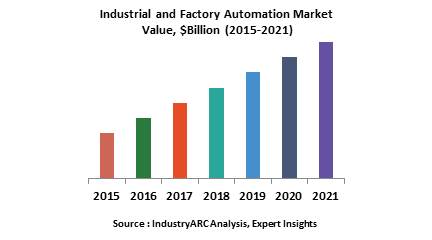Industrial and Factory Automation Market Overview:
Increasing usage of machines, the demand for high quality products with high volume production in various industries, and increasing installation and adoption of smart devices are the factors driving the growth of the industrial and factory automation market during the forecast period 2019 to 2025. Smart devices can communicate with each other within the factory and also with the cloud. According to the fresh market research report from IndustryARC, this is the major factor which is opening up industrial and factory automation market which already has a market size of nearly $5 billion in 2018, and the demand for the same is projected to grow at a notable CAGR of 12% during the forecast period.
Industrial and factory automation refers to the automation of manufacturing, and material handling by using smarter manufacturing infrastructure. Industries are implementing automation to increase productivity and reduce labor costs. Embedded vision is a technology which optimizes the factory production floor in areas such as raw materials handling and assembly. Factory automation uses the pneumatic technology, because it operates at much lower than hydraulic technology. With the adoption of automation, control loops were added to machine operation. These control loops are two types, open control loops that allow for human input and closed loops which are fully automated. The main advantage of these control loops are increase in production, and quality, and reduce in errors.
Europe dominates the Industrial and Factory Automation Market
Europe will dominate the industrial and factory automation market during the forecast period. It is expected to grow at a CAGR of 30% to 35% by 2025. The reason behind this growth can be attributed to extensive use of enabling technologies such as artificial intelligence, big data, and cybersecurity in manufacturing, continuous innovation in industrial robotics, and need for mass production. The sales of robots have increased in the manufacturing industries. Globally, 74 robot units per 10,000 employees is the average robot density as of 2018. By region, Europe has average robot density of 99 units, and then followed by America and Asia by 84 and 63 units respectively. The rising demand for electronic products and the need to automate production driving the demand for factory automation in the region.
Industrial and Factory Automation Market Outlook:
According to the analyst of IndustryARC, the application CAGR of industrial and factory automation market in oil and gas industry will be 2% to 2.5%. The reason behind the growth in this sector is increasing labor wages, and rising adoption of automation in various end user industries to increase productivity and efficiency. Robotics are also used in the oil and gas applications. One of the well-known robot used in this industry is the Iron Roughneck which is made by National Oilwell Varco Inc. This robot is used to automate the repetitive and quite dangerous task of connecting drill pipes.

Cobots: Disruptive Trend in Industrial and Factory Automation Market
- The Cobots or Collaborative Robots are replacing the human jobs which are either too repetitive or dangerous; allowing the human workers to focus on other easy operations in the industries.
- International Data Corporation (IDC) estimates that by 2018, 30% of all new robotic deployments will be smart collaborative robots that operate three times faster than today’s robots and are safe for work around humans.
- Cobots are especially suitable for small and medium-sized companies, which account for 70% of global manufacturing, as they give human workers new tools to complete tasks more quickly, efficiently, and with greater insight than ever before.
Industrial and Factory Automation Market: Competitive Landscape
The major players operating in the industrial and factory automation market are ABB Ltd., Emerson Electric Co., Siemens AG, Omron Corp, Mitsubishi Corp, Honeywell International Inc., General Electric Co, Rockwell Automation, Yokogawa Electric Corp, Schnieder Electric SE, and Fanuc Corp.
Industrial and Factory Automation Market Research Scope:
The base year of the study is 2017, with forecast done up to 2023. The study presents a thorough analysis of the competitive landscape, taking into account the market shares of the leading companies. It also provides information on unit shipments. These provide the key market participants with the necessary business intelligence and help them understand the future of the plastics in the Industrial and Factory Automation Market. The assessment includes the forecast, an overview of the competitive structure, the market shares of the competitors, as well as the market trends, market demands, market drivers, market challenges, and product analysis. The market drivers and restraints have been assessed to fathom their impact over the forecast period. This report further identifies the key opportunities for growth while also detailing the key challenges and possible threats.
Industrial and Factory Automation Market Report: Industry Coverage
The industrial and factory automation market report also analyzes the major geographic regions for the market as well as the major countries for the market in these regions. The regions and countries covered in the study include:
- North America: The U.S., Canada, Mexico
- South America: Brazil, Venezuela, Argentina, Ecuador, Peru, Colombia, Costa Rica
- Europe: The U.K., Germany, Italy, France, The Netherlands, Belgium, Spain, Denmark
- APAC: China, Japan, Australia, South Korea, India, Taiwan, Malaysia, Hong Kong
- Middle East and Africa: Israel, South Africa, Saudi Arabia
"We also publish more than 100 reports every month in “Automation and Instrumentation”, Go through the Domain if there are any other areas for which you would like to get a market research study."










Comments (0)
Post a Comment